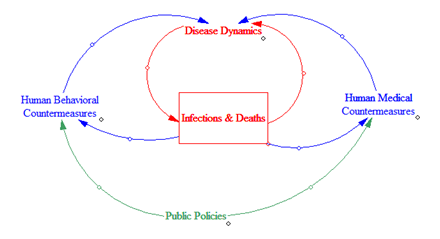COVID-19 Policy Simulator and Learning Environment
Public Outreach Division
Department of Disease Control (DCD)
Ali Mashayekhi, Emeritus Sharif University of Technology
Dan Gordon, Retired
NYS Department of Health
David Andersen, Emeritus
University at Albany-SUNY
Luis Luna-Reyes
University at Albany-SUNY
While the Department of Disease Control (DCD) is a fictious federal agency loosely modeled after the real Center for Disease Control (CDC), the issues and policies portrayed in this simulator are very real. These are the same issues and policies treated in the case study, “Managing COVID-19 Mask and Vaccine Mandates in Albon County, Michigan: What to do when Public Health Policies become Politicized”—the case study for which this simulator was created. This manual is organized into five parts. The first part introduces the simulator with suggestions for how to use it. The next four parts lead you step-by-step through several layers of increasing complexity:
PART 1
PART 5
PART 3
PART 4
PART 5
There is also an appendix that discusses the questions posed in each part of this manual.
The COVID-19 pandemic is a complex dynamic system. As shown in Figure 1, there are three layers of dynamics and response. The first layer, shown in RED in Figure 1, is the dynamics of the COVID-19 virus acting in the absence of any human countermeasures. While the COVID virus has never existed in the absence of human countermeasures, it is instructive to contemplate “what if” it had. The second layer, shown in BLUE in Figure 1, consists of human behavioral and medical countermeasures. Behavioral countermeasures are actions such as wearing masks or keeping socially distant. Medical countermeasures include things like hospitalizations and creating and using vaccines. The third layer, shown in GREEN in Figure 1, consists of policy responses by local, state, and the federal governments. Policies include actions such as mandating mask wearing in certain circumstances, promoting vaccine development, mandating vaccine administration, and so on. All three of these layers have been incorporated into a system dynamics simulation model that, in turn, has been wrapped in a simplified interface that you can use to explore underlying dynamics.

This learning environment is designed to help you explore how public policies can interact with and shape human countermeasures that in turn determine the course of the pandemic. The simulator allows you to design different sorts of pandemics in the absence of any human responses to learn more about pandemic dynamics. Then, you can test in a simulated environment what are the effects of specific human behaviors such as careful behaviors with respect to mask-wearing and social distancing. As you work further with the simulator you will be free to invent many different types of vaccines of varying effectiveness that are taken by a fraction of the population that you can choose. You can even explore what would happen if a new variant of the disease suddenly arose at some future point in time that you get to choose. Finally, you can test government policies such as mandated lockdowns (which the model takes to be mandating the most careful behavior by the population) or increased uptake or effectiveness of available vaccines.
The simulator built into this learning environment is not designed or capable of making precise predictions about the real world. Indeed, time starts at some abstract Day 0 and continues out for 720 days. Instead, the model is good for exploring interactions, for asking “what if” questions to explore what might occur in different versions of a pandemic, with different population responses and different programmatic responses. Anything you learn by running the simulator needs to be brought back to the real-world situation that you are studying, to be put in context and sensibly interpreted.

